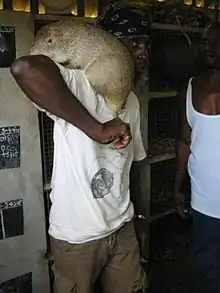| Thryonomyidae[1] | |||
| G.S. Miller & Gidley, 1918[2] | |||
| Okres istnienia: eocen–holocen | |||
 Przedstawiciel rodziny – szczeciniec większy (Thryonomys swinderianus) | |||
| Systematyka | |||
| Domena | |||
|---|---|---|---|
| Królestwo | |||
| Typ | |||
| Podtyp | |||
| Nadgromada | |||
| Gromada | |||
| Podgromada | |||
| Infragromada | |||
| Rząd | |||
| Podrząd | |||
| Infrarząd | |||
| (bez rangi) | Phiomorpha | ||
| Rodzina |
szczecińcowate | ||
| Typ nomenklatoryczny | |||
|
Thryonomys Fitzinger, 1867 | |||
| Synonimy | |||
|
| |||
| Rodzaje | |||
| |||
Szczecińcowate[7] (Thryonomyidae) – rodzina ssaków z infrarzędu jeżozwierzokształtnych (Hystricognathi) w obrębie rzędu gryzoni (Rodentia).
Zasięg występowania
Rodzina obejmuje dwa współcześnie żyjące gatunki występujące w Afryce.
Morfologia
Przedstawiciele szczecińcowatych to duże gryzonie, ważące do 9 kg. Mają dużą głowę z małymi oczami i uszami oraz krótki, owłosiony ogon. Mocne pazury na łapach przystosowane są do kopania w ziemi. Pomarańczowe zęby, jak u wszystkich gryzoni, rosną przez całe życie.
Ekologia
Żyją na podmokłych, trawiastych terenach. Czasami zamieszkują pola uprawne i zjadają plony. Są z natury samotnikami, choć czasami łączą się w niewielkie grupy.
Systematyka
Do rodziny należy tylko jeden występujący współcześnie rodzaj[8][9][7]:
- Thryonomys Fitzinger, 1867 – szczeciniec
- Apodecter Hopwood, 1929[12]
- Epiphiomys Lavocat, 1973[13] – jedynym przedstawicielem był Epiphiomys coryndoni Lavocat, 1973
- Kochalia De Bruijn, 1986[14] – jedynym przedstawicielem był Kochalia geespei (De Bruijn & Hussain, 1985)
- Neophiomys Coster, Benammi, Salem, Bilal, Chaimanee, Valentin, Brunet & Jaeger, 2012[15]
- Neosciuromys Stromer, 1922[16]
- Paraphiomys C.W. Andrews, 1914[17]
- Paraulacodus Hinton, 1933[18]
- Protohummus Kraatz, Bibi, Hill & Beech, 2013[19] – jedynym przedstawicielem był Protohummus dango Kraatz, Bibi, Hill & Beech, 2013
- Sacaresia Hugueney & Adrover, 1991[20] – jedynym przedstawicielem był Sacaresia moyaeponsi Hugueney & Adrover, 1991
Uwagi
Przypisy
- ↑ Thryonomyidae, [w:] Integrated Taxonomic Information System (ang.).
- ↑ G.S. Miller & J.W. Gidley. Synopsis of the supergeneric groups of rodents. „Journal of the Washington Academy of Sciences”. 8, s. 446, 1918. (ang.).
- ↑ Ch.L. Bonaparte: Catalogo metodico dei mammiferi europei. Milano: Luigi di Giacomo Pirola, 1845, s. 5. (fr.).
- ↑ J.F. von Brandt. Beiträge zur nähern Kenntniss der Säugethiere Russland’s. „Mémoires de l’Académie Impériale des Sciences de Saint-Pétersbourg”. 6e série. Sciences naturelles. 7 (2), s. 251, 1855. (niem.).
- ↑ R.I. Pocock. On the external characters of some hystricomorph rodents. „Proceedings of the Zoological Society of London”. 1922 (2), s. 423, 1922. (ang.).
- ↑ A.E. Wood. A revised classification of the rodents. „Journal of Mammalogy”. 36 (2), s. 183, 1955. DOI: 10.2307/1375874. (ang.).
- 1 2 Nazwy zwyczajowe za: W. Cichocki, A. Ważna, J. Cichocki, E. Rajska-Jurgiel, A. Jasiński & W. Bogdanowicz: Polskie nazewnictwo ssaków świata. Warszawa: Muzeum i Instytut Zoologii PAN, 2015, s. 287. ISBN 978-83-88147-15-9. (pol. • ang.).
- ↑ N. Upham, C. Burgin, J. Widness, M. Becker, C. Parker, S. Liphardt, I. Rochon & D. Huckaby: Treeview of Mammalian Taxonomy Hierarchy. [w:] ASM Mammal Diversity Database (Version 1.11) [on-line]. American Society of Mammalogists. [dostęp 2023-10-14]. (ang.).
- ↑ C.J. Burgin, D.E. Wilson, R.A. Mittermeier, A.B. Rylands, T.E. Lacher & W. Sechrest: Illustrated Checklist of the Mammals of the World. Cz. 1: Monotremata to Rodentia. Barcelona: Lynx Edicions, 2020, s. 544. ISBN 978-84-16728-34-3. (ang.).
- ↑ J.S. Zijlstra, Thryonomyidae Miller & Gidley, 1918, Hesperomys project (Version 23.8.1), DOI: 10.5281/zenodo.7654755 [dostęp 2023-10-14] (ang.).
- ↑ R.L. Antoñanzas, S. Sevket & P. Mein. Systematics and phylogeny of the cane rats (Rodentia: Thryonomyidae). „Zoological Journal of the Linnean Society”. 142 (3,), s. 423–444, 2004. American Society of Mammologists. (ang.).
- ↑ A.T. Hopwood. New and little-known mammals from the Miocene of Africa. „American Museum Novitates”. 344, s. 3, 1929. (ang.).
- ↑ R. Lavocat. Les rongeurs du Miocène d’Afrique Orientale. Miocène inférieur. „Memoires et Travaux de l’Institut de Montpellier de l’Ecole Pratique des Hautes Etudes”. 1, s. 46, 1973. (fr.).
- ↑ H. de Bruijn. Is the presence of the African family Thryonomyidae in the Miocene deposits of Pakistan evidence for fauna exchange?. „Proceedings of the Koninklijke Nederlandse Akademie van Wetenschappen”. Series B. 89 (2), s. 125, 1986. (ang.).
- ↑ P. Coster, M. Benammi, M. Salem, A.A. Bilal, Y. Chaimanee, X. Valentin, M. Brunet & J.-J. Jaeger. New hystricognathous rodents from the Early Oligocene of central Libya (Zallah Oasis, Sahara Desert): Systematic, phylogenetic, and biochronologic implications. „Annals of the Carnegie Museum”. 80 (3), s. 242, 2012. DOI: 10.2992/007.080.0304. (ang.).
- ↑ E. Stromer. Erste Mitteilung über Tertiäre Wirbeltier-Reste aus Deutsch-Südwestafrika. „Sitzungsberichte der Mathematisch-Physikalischen Klasse der Bayerischen Akademie der Wissenschaften zu München”. Jahrgang 1921, s. 333, 1922. (niem.).
- ↑ Ch.W. Andrews. On the Lower Miocene vertebrates from British East Africa collected by Dr Felix Oswald. „The Quarterly journal of the Geological Society of London”. 70, s. 178, 1914. (ang.).
- ↑ M.A.C. Hinton. Diagnoses of new genera and species of rodents from Indian Tertiary deposits. „The Annals and Magazine of Natural History”. Tenth series. 12 (72), s. 621, 1933. DOI: 10.1080/00222933308673728. (ang.).
- ↑ B.P. Kraatz, F. Bibi, A. Hill & M. Beech. A new fossil thryonomyid from the Late Miocene of the United Arab Emirates and the origin of African cane rats. „Naturwissenschaften”. 100 (5), s. 441, 2013. DOI: 10.1007/s00114-013-1043-4. (ang.).
- ↑ M. Hugueney & R. Adrover. Sacaresia moyaeponsi nov. gen. nov. sp., rongeur Thryonomyidé (Mammalia) dans le Paléogène de Majorque (Baléares, Espagne). „Geobios”. 24 (2), s. 208, 1991. DOI: 10.1016/S0016-6995(91)80008-N. (fr.).
Bibliografia
- Mystacinidae. Animal Diversity Web. [dostęp 2010-03-25]. (ang.).